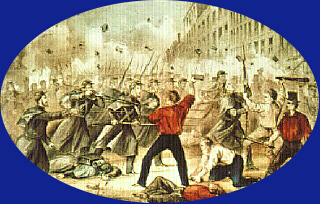On
April 19, 1861, citizens savagely attacked the U.S. volunteers of
the Sixth Massachusetts Regiment in the heart of Baltimore. Four
soldiers died and scores were seriously wounded. In reaction, many
northern newspapers called for martial retribution against the apparently
Secessionist populace of Maryland's largest and most important city.
Sarah Mills, a Baltimore resident, wrote a letter defending the national
loyalty of her fellow citizens to a Northern relative; its text subsequently
appeared in the Boston Transcript. Challenging the current
overwhelmingly negative perception of
Baltimoreans in the North, the Massachusetts-born
Mills
penned:
I assure you there are
many more loyal men and women in this city than many at the North are willing
to believe. . . . When this war for Constitutional government against anarchy
and violence, is ended in triumph, and end it will, then you will find
that Baltimore will have a record of heroism to show that may serve to
hide in part at least her blushes for the crimes of her unworthy sons.
Baltimoreans loyal to the Union
rallied to the aid and comfort
of United States troops within their
city throughout the Civil
War. Often, it was women,
prompted by compassion,
benevolence, and a patriotic spirit,
that provided the moral
impetus and energy to lead soldier
relief activities. These
women's efforts ultimately achieved
their finest expression in
the 1864 Maryland State Fair for
U.S. Soldier Relief, or as it
is more commonly known, the Baltimore
Sanitary Fair. This
article uncovers the major role
of Maryland's Unionist women
in the planning, fundraising, and
execution of this event. In
doing so, it provides important
evidence of their vital
homefront role.
The lack of recognition of the benevolent
efforts of Baltimore
Unionists, and of women Unionists
in particular, in current
viewpoints stems primarily from
three factors. First, and most
importantly, a flawed historiographical
foundation has
prevented a balanced presentation
of Baltimore's war-time
societal dynamics. Pro-Confederate
bias characterized the
narrative of most nineteenth century
local histories depicting
Civil War era Baltimore. J.
Thomas Scharf, a Confederate
veteran, greatly shaped subsequent
local and general histories
of the city. One recent appraisal
of Scharf's Civil War
narrative stated that, his "logic
twisted" as his work reflected
"the bitterness [he] carried with
him after the defeat of the
South." Scharf
often minimized details of Unionist activities or omitted them altogether.
A second factor is the lack of recent
comprehensive research
into Baltimore's social history
during this period. While such
study has been undertaken regarding
other Civil War era urban communities, scholars have continued to overlook
the
Monumental City. Past
scholarship regarding Baltimore, save for few exceptions, tended to concentrate
on the April 19 riot
and its aftermath. Too often
the attack provides a summary
shorthand to general historians
in characterizing the population
and the very complex issue of national
loyalty in the war-time
city. This viewpoint marginalizes
the war-time activities of
Baltimore Unionists and promotes
the impression of
Maryland's general population favoring
secession.
Third, and lastly, much past historical
writing has generally discounted or ignored the contributions of women.
Today's scholarly researchers must devote great effort to uncover the
historical role of women. It is arduous, if not sometimes impossible,
to garner an in-depth understanding. Most archival repository holdings
over-represent the papers of the upper-class native males and traditionally
exclude less socially
prominent, immigrant, and minority
women. However, through a careful study of scarce primary resources,
including period newspapers and organizational reports, Unionist women's
roles begin to emerge from the milieu of a divided citizenry that characterized
Civil War Baltimore.
|

![]()
